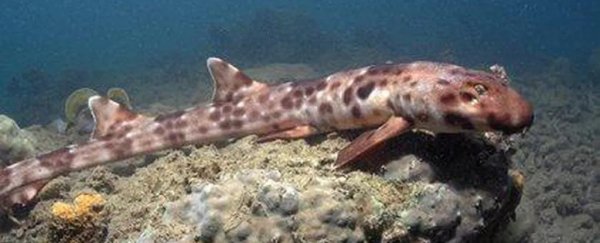In an epic 12-year research effort, an international team of scientists has discovered four species of 'walking sharks', almost doubling the known species count of these rare and gifted animals.
While the image of a shark chasing you onto a sandy beach may now be firmly planted in your mind, that's not how the physiology of these animals works – and there's nothing to fear from these species found in tropical waters between northern Australia and New Guinea (unless you're a tiny marine animal, that is).
"At less than a metre [3.3 ft] long on average, walking sharks present no threat to people," says biologist Christine Dudgeon from the University of Queensland in Australia.
"But their ability to withstand low-oxygen environments and walk on their fins gives them a remarkable edge over their prey of small crustaceans and molluscs."
The four new shark species belong to the genus Hemiscyllium. The new members of the group were linked to five existing kinds of shark through genetic analyses, using tissue samples from live-caught specimens found during the study.
"We estimated the connection between the species based on comparisons between their mitochondrial DNA which is passed down through the maternal lineage," Dudgeon says.
"This DNA codes for the mitochondria, which are the parts of cells that transform oxygen and nutrients from food into energy for cells."
The results confirmed the new animals' DNA was consistent with existing Hemiscyllium species, which can be traced back to the Late Cretaceous period, extending from roughly 66 to 100 million years ago.
Given the immense time scales involved, and the broad scope of international waters, it can be difficult to know exactly how these walking shark species came to be, and why they evolved their separate adaptations.
"It can be challenging to identify the forces that drive speciation in marine environments for organisms that are capable of widespread dispersal because their contemporary distributions often belie the historical processes that were responsible for their initial diversification," the authors explain in their paper.
Nonetheless, we can speculate. In this instance, the researchers suggest Hemiscyllium may have effectively hitch-hiked around the place while geographical shifts emerged over aeons, as tectonic activity and sea-level changes shifted the positions of reefs and island chains.
"Data suggests the new species evolved after the sharks moved away from their original population, became genetically isolated in new areas and developed into new species," Dudgeon says.
"They may have moved by swimming or walking on their fins, but it's also possible they 'hitched' a ride on reefs moving westward across the top of New Guinea, about 2 million years ago."
The team says more walking shark species are likely to exist, too – it's just a matter of finding them.
The findings are reported in Marine and Freshwater Research.
